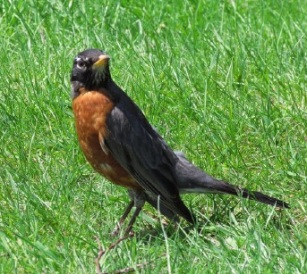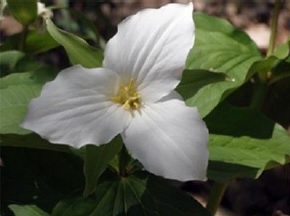Monday, Apr 9, 2018
By Abby Pointer, MNA Intern
As usual, Michigan is having a little bit of trouble deciding when it wants to transition into springtime. Don’t let the occasional snow shower worry you, there are a few sure signs that you can look for to keep up hope that spring is on its way! Michigan’s beloved flora and fauna will bring the sounds and sights of springtime, such as the spring peeper, the American robin, and wild trilliums.
Some music to your ears might be the classic “tinkling of bells” of the Michigan spring peeper. Around early March, when the ground begins thawing, this abundant amphibian species begins its mating season. The peeping you hear is the male frog calling out to potential mates. The more intense the peeping, the more likely the males are to attract their desired female. If you live near wetland areas, such as a damp woodland, marsh, or pond, you are likely to hear these creatures singing away on a warming spring night.

Spring peeper. Photo: Tim Mayo.
While the spring peepers sing you to sleep, another sign that spring is near is being awoken by the return of migratory birds. The classic harbinger of spring is the American robin, Michigan’s state bird. You might recognize its song from the often repeated whistle of cheerily, cheer up, cheer up, cheerily, cheer up. When the average temperature fluctuates around 37 degrees, the male robins will be the first to make themselves known as they establish territories and begin feeding. Female robins will return a couple weeks later to begin building nests and feeding on worms from the thawing grounds. You’ll hear them start singing as they arrive on their breeding territories!

American robin. Photo: Tara Rampersad.
While the spring peepers sing you to sleep, another sign that spring is near is being awoken by the return of migratory birds. The classic harbinger of spring is the American robin, Michigan’s state bird. You might recognize its song from the often repeated whistle of cheerily, cheer up, cheer up, cheerily, cheer up. When the average temperature fluctuates around 37 degrees, the male robins will be the first to make themselves known as they establish territories and begin feeding. Female robins will return a couple weeks later to begin building nests and feeding on worms from the thawing grounds. You’ll hear them start singing as they arrive on their breeding territories!
Another bird that is usually a first sign of spring in Michigan is the red-winged blackbird, with some arriving as early as mid-February. Males will sing their song, conk-la-ree from a high perch, awaiting the female response of a series of several chits. These birds prefer wetland areas, so if you are near standing water and vegetation, look out for these birds. You will also start seeing more shorebirds and hearing more owls and woodpeckers. The return of these birds from late March through May marks prime bird watching season.
You might notice the budding of trees, and if you look closely some wildflowers are indicators that spring is on its way. The endangered trillium is one that you might see first, a three petaled flower with dark green leaves and pale green accents. The arrival of the wildflowers ushers in the return of pollinators to help speed the spring process along!

Trillium. Photo: Mary Bohling.
